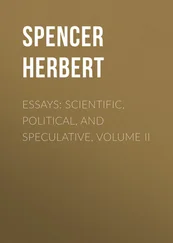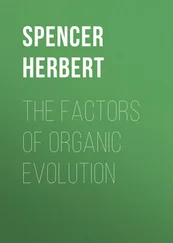Yet another generalization of like universality expresses the process of organic development. To the ordinary observer there seems no unity in this. No obvious parallelism exists between the unfolding of a plant and the unfolding of an animal. There is no manifest similarity between the development of a mammal, which proceeds without break from its first to its last stage, and that of an insect, which is divided into strongly-marked stages—egg, larva, pupa, imago. Nevertheless it is now an established fact, that all organisms are evolved after one general method. At the outset the germ of every plant or animal is relatively homogeneous; and advance towards maturity is advance towards greater heterogeneity. Each organized thing commences as an almost structureless mass, and reaches its ultimate complexity by the establishment of distinctions upon distinctions—by the divergence of tissues from tissues and organs from organs. Here, then, we have yet another biological law of transcendent generality.
Having thus recognized the scope of Transcendental Physiology as presented in its leading truths, we are prepared for the considerations that are to follow.
And first, returning to the last of the great generalizations above given, let us inquire more nearly how this change from the homogeneous to the heterogeneous is carried on. Usually it is said to result from successive differentiations. This, however, cannot be considered a complete account of the process. During the evolution of an organism there occur, not only separations of parts, but coalescences of parts. There is not only segregation, but aggregation. The heart, at first a simple pulsating blood-vessel, by and by twists upon itself and becomes integrated. The bile-cells constituting the rudimentary liver, do not merely diverge from the surface of the intestine in which they at first form a simple layer; but they simultaneously consolidate into a definite organ. And the gradual concentration seen in these and other cases is a part of the developmental process—a part which, though more or less recognized by Milne-Edwards and others, does not seem to have been included as an essential element in it.
This progressive integration, manifest alike when tracing up the several stages passed through by every embryo, and when ascending from the lower organic forms to the higher, may be most conveniently studied under several heads. Let us consider first what may be called longitudinal integration .
The lower Annulosa —worms, myriapods, &c.—are characterized by the great numbers of segments of which they respectively consist, reaching in some cases to several hundreds; but as we advance to the higher Annulosa —centipedes, crustaceans, insects, spiders—we find these numbers greatly reduced, down to twenty-two, thirteen, and even fewer; and accompanying this there is a shortening or integration of the whole body, reaching its extreme in crabs and spiders. Similarly with the development of an individual crustacean or insect. The thorax of a lobster, which, in the adult, forms, with the head, one compact box containing the viscera, is made up by the union of a number of segments which in the embryo were separable. The thirteen distinct divisions seen in the body of a caterpillar, become further integrated in the butterfly: several segments are consolidated to form the thorax, and the abdominal segments are more aggregated than they originally were. The like truth is seen when we pass to the internal organs. In the lower annulose forms, and in the larvæ of the higher ones, the alimentary canal consists either of a tube that is uniform from end to end, or else bulges into a succession of stomachs, one to each segment; but in the developed forms there is a single well-defined stomach. In the nervous, vascular, and respiratory systems a parallel concentration may be traced. Again, in the development of the Vertebrata we have sundry examples of longitudinal integration. The coalescence of several segmental groups of bones to form the skull is one instance of it. It is further illustrated in the os coccygis , which results from the fusion of a number of caudal vertebræ. And in the consolidation of the sacral vertebræ of a bird it is also well exemplified.
That which we may distinguish as transverse integration , is well illustrated among the Annulosa in the development of the nervous system. Leaving out those simple forms which do not present distinct ganglia, it is to be observed that the lower annulose animals, in common with the larvæ of the higher, are severally characterized by a double chain of ganglia running from end to end of the body; while in the more advanced annulose animals this double chain becomes a single chain. Mr. Newport has described the course of this concentration in insects; and by Rathke it has been traced in crustaceans. In the early stages of the Astacus fluviatilis , or common cray-fish, there is a pair of separate ganglia to each ring. Of the fourteen pairs belonging to the head and thorax, the three pairs in advance of the mouth consolidate into one mass to form the brain, or cephalic ganglion. Meanwhile out of the remainder, the first six pairs severally unite in the median line, while the rest remain more or less separate. Of these six double ganglia thus formed, the anterior four coalesce into one mass; the remaining two coalesce into another mass; and then these two masses coalesce into one. Here we see longitudinal and transverse integration going on simultaneously; and in the highest crustaceans they are both carried still further. The Vertebrata exhibit this transverse integration in the development of the generative system. The lowest of the mammalia—the Monotremata —in common with birds, have oviducts which towards their lower extremities are dilated into cavities severally performing in an imperfect way the function of a uterus. "In the Marsupialia , there is a closer approximation of the two lateral sets of organs on the median line; for the oviducts converge towards one another and meet (without coalescing) on the median line; so that their uterine dilatations are in contact with each other, forming a true 'double uterus.' … As we ascend the series of 'placental' mammals, we find the lateral coalescence becoming gradually more and more complete. … In many of the Rodentia , the uterus still remains completely divided into two lateral halves; whilst in others, these coalesce at their lower portion, forming a rudiment of the true 'body' of the uterus in the Human subject. This part increases at the expense of the lateral 'cornua' in the higher Herbivora and Carnivora; but even in the lower Quadrumana, the uterus is somewhat cleft at its summit." [6]And this process of transverse integration, which is still more striking when observed in its details, is accompanied by parallel though less important changes in the opposite sex. Once more; in the increasing commissural connexion of the cerebral hemispheres, which, though separate in the lower vertebrata, become gradually more united in the higher, we have another instance. And further ones of a different order, but of like general implication, are supplied by the vascular system.
Now it seems to us that the various kinds of integration here exemplified, which are commonly set down as so many independent phenomena, ought to be generalized, and included in the formula describing the process of development. The fact that in an adult crab, many pairs of ganglia originally separate have become fused into a single mass, is a fact only second in significance to the differentiation of its alimentary canal into stomach and intestine. That in the higher Annulosa , a single heart replaces the string of rudimentary hearts constituting the dorsal blood-vessel in the lower Annulosa , (reaching in one species to the number of one hundred and sixty), is a truth as much needing to be comprised in the history of evolution, as is the formation of a respiratory surface by a branched expansion of the skin. A right conception of the genesis of a vertebral column, includes not only the differentiations from which result the chorda dorsalis and the vertebral segments imbedded in it; but quite as much it includes the coalescence of numerous vertebral processes with their respective vertebral bodies. The changes in virtue of which several things become one, demand recognition equally with those in virtue of which one thing becomes several. Evidently, then, the current statement which ascribes the developmental progress to differentiations alone, is incomplete. Adequately to express the facts, we must say that the transition from the homogeneous to the heterogeneous is carried on by differentiations and accompanying integrations.
Читать дальше












